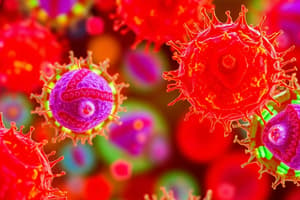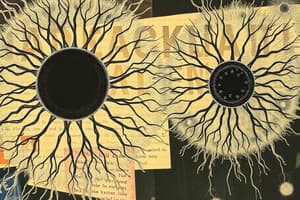Podcast
Questions and Answers
What is the smallest unit of life that can replicate independently?
What is the smallest unit of life that can replicate independently?
- Organism
- Cell (correct)
- Organ
- Tissue
What is the function of the cell membrane in eukaryotic cells?
What is the function of the cell membrane in eukaryotic cells?
- To store genetic material
- To synthesize proteins
- To provide energy for the cell
- To control what substances can pass in and out of the cell (correct)
What is the main function of mitochondria in eukaryotic cells?
What is the main function of mitochondria in eukaryotic cells?
- Energy production through aerobic respiration (correct)
- Photosynthesis
- Protein synthesis
- Storage of genetic material
What is the primary function of chloroplasts in plant cells?
What is the primary function of chloroplasts in plant cells?
What is the main difference between prokaryotic and eukaryotic cells?
What is the main difference between prokaryotic and eukaryotic cells?
What is the function of the cell wall in plant cells?
What is the function of the cell wall in plant cells?
What is unique about the DNA in prokaryotic cells?
What is unique about the DNA in prokaryotic cells?
What is the function of flagella in some bacterial cells?
What is the function of flagella in some bacterial cells?
What is the primary function of the nucleus in eukaryotic cells?
What is the primary function of the nucleus in eukaryotic cells?
What is the main component of a plant cell wall?
What is the main component of a plant cell wall?
What is the primary function of ribosomes in eukaryotic cells?
What is the primary function of ribosomes in eukaryotic cells?
What is the main function of the vacuole in plant cells?
What is the main function of the vacuole in plant cells?
What is unique about the genetic material in prokaryotic cells?
What is unique about the genetic material in prokaryotic cells?
What is the primary function of chloroplasts in plant cells?
What is the primary function of chloroplasts in plant cells?
What is the primary characteristic of prokaryotic cells?
What is the primary characteristic of prokaryotic cells?
What is the primary function of the cytoplasm in eukaryotic cells?
What is the primary function of the cytoplasm in eukaryotic cells?
Flashcards are hidden until you start studying
Study Notes
Cells: The Basic Building Blocks of Life
- Cells are the smallest unit of life that can replicate independently.
- They are the basic building blocks of life, and all living organisms are made up of cells.
Eukaryotic Cells (Animal and Plant Cells)
- Both animal and plant cells are eukaryotic cells.
- They have a cell membrane that controls what substances can pass in and out of the cell.
- They have a nucleus that contains the genetic material (DNA) and controls the activities of the cell.
- They are filled with a gel-like substance called cytoplasm, where chemical reactions take place.
- They have mitochondria that provide energy for the cell through aerobic respiration.
- They have ribosomes that are the site of protein synthesis.
Plant Cells
- Plant cells have a rigid cell wall around the entire cell, made up of cellulose.
- The cell wall provides support and structure to the cell.
- They have a permanent vacuole, a large sac that contains cell sap (a mixture of sugars, salts, and water).
- They have chloroplasts, where photosynthesis occurs, and contain chlorophyll, which absorbs light energy.
Prokaryotic Cells (Bacterial Cells)
- Bacterial cells are prokaryotic cells and consist of a single cell (unicellular).
- They have a cell membrane, a cell wall, ribosomes, and cytoplasm.
- They do not have mitochondria or chloroplasts.
- They do not have a nucleus; instead, they have a single circular strand of DNA (circular chromosome or nucleoid) that contains all the genes needed for survival and reproduction.
- Some bacteria have additional small rings of DNA called plasmids, which carry extra genes like antibiotic resistance.
- Some bacteria have flagella, thread-like structures that allow them to move around.
Cells: The Basic Building Blocks of Life
- Cells are the smallest unit of life that can replicate independently.
- All living organisms are made up of cells.
Eukaryotic Cells (Animal and Plant Cells)
- Cell membrane controls what substances can pass in and out of the cell.
- Nucleus contains genetic material (DNA) and controls cell activities.
- Cytoplasm is a gel-like substance where chemical reactions take place.
- Mitochondria provide energy for the cell through aerobic respiration.
- Ribosomes are the site of protein synthesis.
Plant Cells
- Rigid cell wall provides support and structure to the cell.
- Cell wall is made up of cellulose.
- Permanent vacuole is a large sac that contains cell sap (a mixture of sugars, salts, and water).
- Chloroplasts are where photosynthesis occurs and contain chlorophyll, which absorbs light energy.
Prokaryotic Cells (Bacterial Cells)
- Bacterial cells are single-celled (unicellular).
- Cell membrane, cell wall, ribosomes, and cytoplasm are present.
- Mitochondria and chloroplasts are absent.
- A single circular strand of DNA (circular chromosome or nucleoid) contains all genes needed for survival and reproduction.
- Plasmids are small rings of DNA that carry extra genes like antibiotic resistance.
- Some bacteria have flagella, thread-like structures that allow them to move around.
Cells: The Basic Building Blocks of Life
- Cells are the smallest unit of life that can replicate independently.
- All living organisms are made up of cells.
Eukaryotic Cells (Animal and Plant Cells)
- Cell membrane controls what substances can pass in and out of the cell.
- Nucleus contains genetic material (DNA) and controls cell activities.
- Cytoplasm is a gel-like substance where chemical reactions take place.
- Mitochondria provide energy for the cell through aerobic respiration.
- Ribosomes are the site of protein synthesis.
Plant Cells
- Rigid cell wall provides support and structure to the cell.
- Cell wall is made up of cellulose.
- Permanent vacuole is a large sac that contains cell sap (a mixture of sugars, salts, and water).
- Chloroplasts are where photosynthesis occurs and contain chlorophyll, which absorbs light energy.
Prokaryotic Cells (Bacterial Cells)
- Bacterial cells are single-celled (unicellular).
- Cell membrane, cell wall, ribosomes, and cytoplasm are present.
- Mitochondria and chloroplasts are absent.
- A single circular strand of DNA (circular chromosome or nucleoid) contains all genes needed for survival and reproduction.
- Plasmids are small rings of DNA that carry extra genes like antibiotic resistance.
- Some bacteria have flagella, thread-like structures that allow them to move around.
Studying That Suits You
Use AI to generate personalized quizzes and flashcards to suit your learning preferences.




